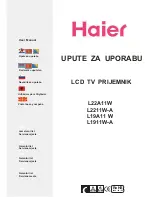
FCC ID: K6620224X20
IC IF: 511B-20224X20
Alignment
Vertex Standard Co., Ltd.
2
Required Test Equipment
The following test equipment (and thorough familiarity with its correct use) is necessary for
complete realignment. Correction of problems caused by misalignment resulting from use of
improper test equipment is not covered under the warranty policy. While most steps do not
require all of the equipment listed, the interactions of some adjustments may require that
more complex adjustments be performed afterwards. Do not attempt to perform only a
single step unless it is clearly isolated electrically from all other steps. Have all test
equipment ready before beginning, and follow all of the steps in a section in the order
presented.
Regulated DC Power Supply: adjustable from 5 to 16 VDC, 3 A
RF Signal Generator with calibrated output level at 500 MHz
Frequency Counter: ±0.1 ppm accuracy at 500 MHz
AF Signal Generator
SINAD
Meter
Oscilloscope
Spectrum
Analyzer
Deviation Meter (linear detector)
AF
Milivoltmetr
AF Dummy Load: 8
Ω
, 1 W
DC Voltmeter: high impedance
Inline Wattmeter with 5% accuracy at 500 MHz
50-Ohm non-reactive Dummy Load: 10 watts at 500 MHz
VHF/UHF Sampling Coupler
Alignment Preparation & Precautions
A dummy load and inline wattmeter must be connected to the main antenna jack in all
procedures that call for transmission, except where specified otherwise. Correct alignment is
not possible with an antenna. After completing one step, read the following step to
determine whether the same test equipment will be required. If not, remove the test
equipment (except dummy load and wattmeter, if connected) before proceeding.
Correct alignment requires that the ambient temperature in the repair shop be the same as
that of the transceiver and test equipment, and that this temperature be held constant
between 20 °C and 30 °C (68 °C to 86 °F). When the transceiver is brought into the shop
from hot or cold air it should be allowed some time for thermal equalization with the
environment before alignment. If possible, alignments should be made with oscillator shields






















